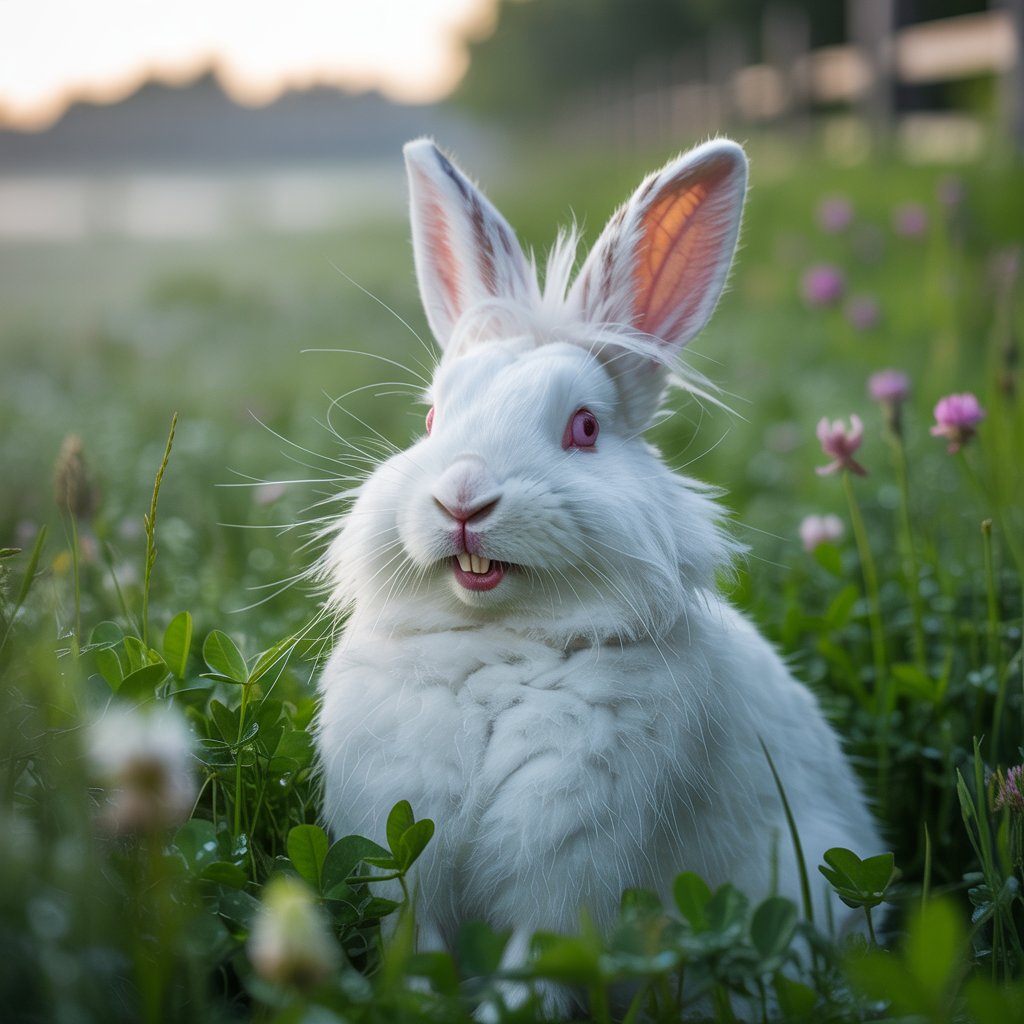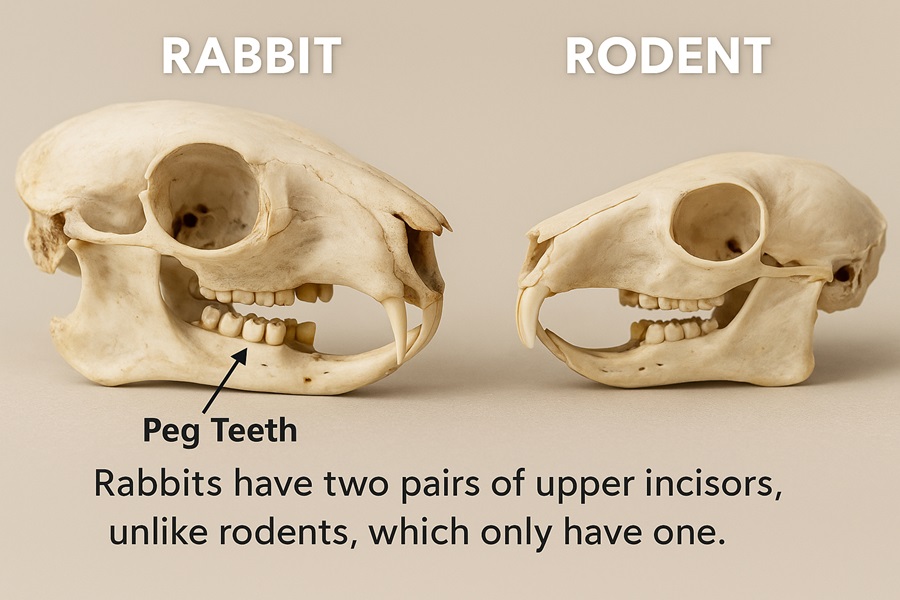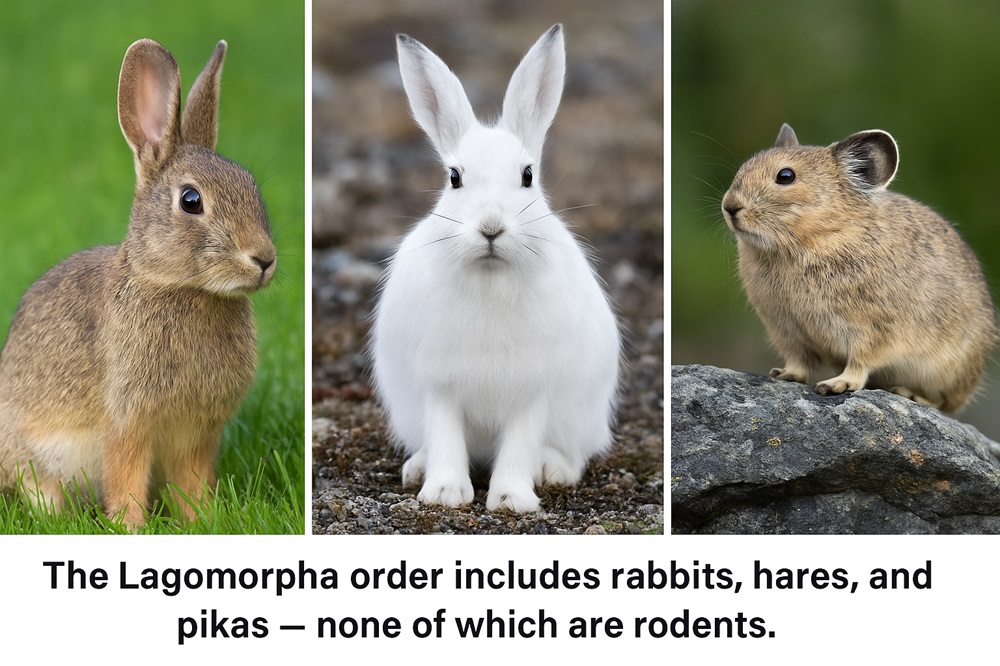Rabbits are everywhere — hopping through meadows, nibbling in gardens, or curled up as pets. With their twitching noses, floppy ears and constant chewing they seem to have a lot in common with rodents like mice and rats. So many people ask the question: Are rabbits rodents?
It’s a common misconception but the scientific truth is clear — rabbits are not rodents. Instead they belong to a separate order of mammals called Lagomorpha which also includes hares and pikas. Their unique dental structure, digestive system and evolutionary history puts them in a different branch of the mammal family tree.
Are rabbits rodents?
No, rabbits are not rodents. Although they share some traits with rats and mice — like ever-growing teeth and plant-based diets — rabbits belong to a different order of mammals called Lagomorpha which includes hares and pikas. Their unique dental structure and evolutionary history sets them apart from true rodents.
Why People Think Rabbits Are Rodents
There are a few obvious reasons why rabbits get lumped in with rodents:
- Ever-growing teeth – Like rodents, rabbits’ incisors never stop growing.
- Small size and diet – Both rely on plants, seeds and grasses.
- Gnawing behavior – Rabbits, like rats and mice, chew to wear down their teeth.
Culturally, cartoons and casual references group rabbits with rats or mice, so it’s no wonder the myth persists. Even in early scientific classification rabbits were considered rodents — a mistake that stuck for decades.
Historical Classification: Why Rabbits Were Once Considered Rodents
For much of the 19th and early 20th centuries, scientists placed rabbits in the order Rodentia alongside rats, mice, and squirrels. The logic was simple: their large front teeth and chewing habits looked rodent-like.
This changed in 1912, when researchers discovered that rabbits have an extra pair of small incisors hidden behind the main upper ones — a feature absent in rodents. This critical dental distinction led to their reclassification into a brand-new order: Lagomorpha.
The history explains why so many people still believe rabbits are rodents: for decades, they technically were, until science corrected the record.
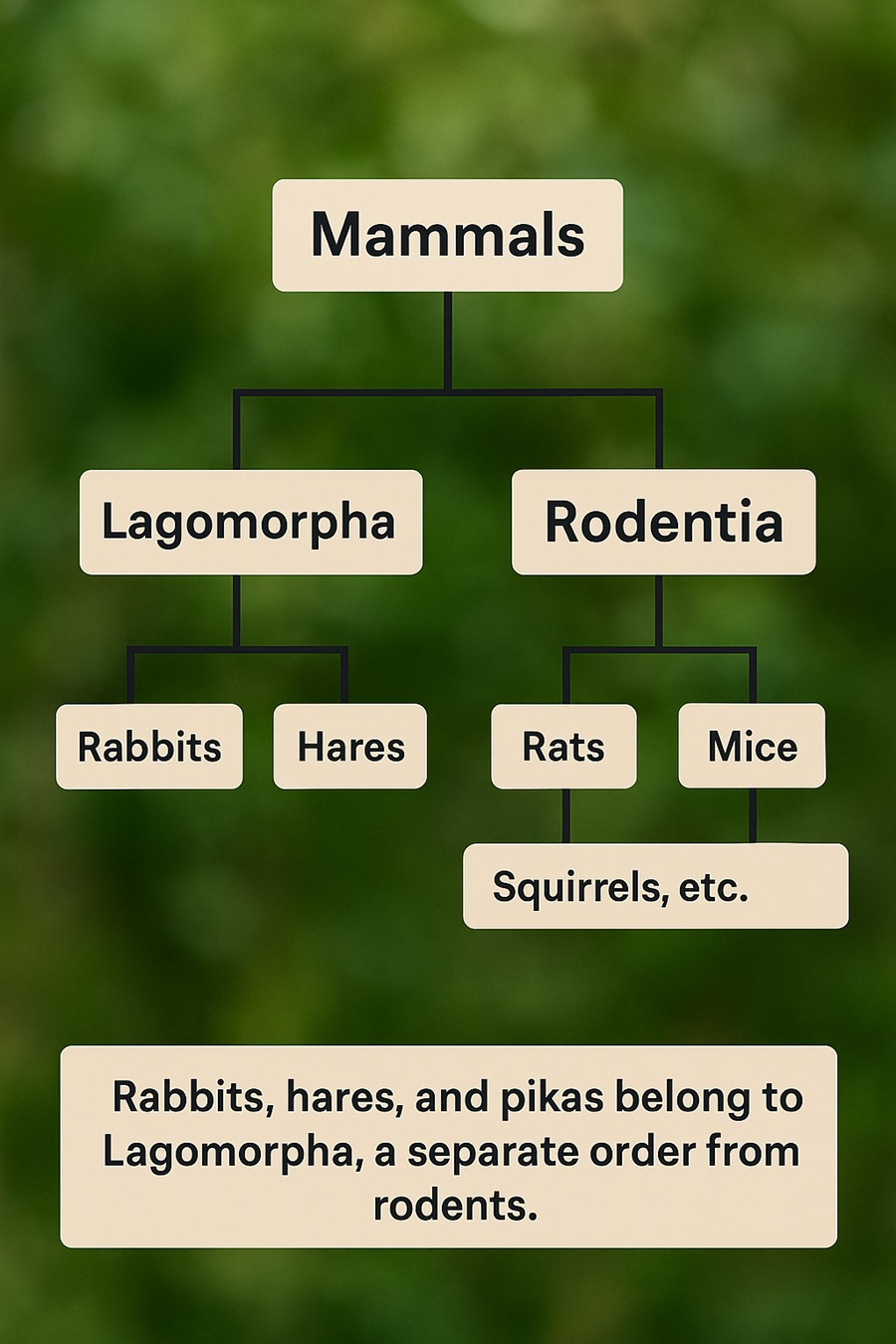
Scientific Classification of Rabbits
Let’s look at where rabbits truly belong in the mammal kingdom:
- Kingdom: Animalia
- Phylum: Chordata
- Class: Mammalia
- Order: Lagomorpha
- Family: Leporidae (rabbits and hares)
Their closest relatives are hares and pikas, not mice or rats. This taxonomy highlights a clear divide between Lagomorpha and Rodentia, even though both fall under the broader class of mammals.
What Is Lagomorpha?
The order Lagomorpha includes three groups of animals: rabbits, hares, and pikas. Unlike rodents, lagomorphs have two pairs of upper incisors — the large front teeth plus a smaller set known as peg teeth. They are strictly herbivores, adapted to grazing on grasses and fibrous plants, and have a specialized digestive process that includes re-ingesting nutrient-rich droppings (cecotrophy).
This order is much smaller than Rodentia, which has over 2,000 species. By contrast, Lagomorpha contains only about 100 species worldwide. That difference in diversity reflects how rabbits and their relatives occupy a narrower ecological niche compared to rodents.
Are Rabbits Related to Mice and Rats?
The short answer: No.
- Mice and Rats belong to the order Rodentia, which contains over 2,000 species, including squirrels, beavers, and guinea pigs.
- Rabbits belong to the order Lagomorpha, which includes only rabbits, hares, and pikas.
Though both are mammals, their evolutionary paths diverged 55–65 million years ago. The similarity in teeth and chewing habits is a case of convergent evolution — when unrelated animals evolve similar traits due to similar survival needs.
So, while rabbits look rodent-like, they are no more closely related to rats than cats are to dogs.
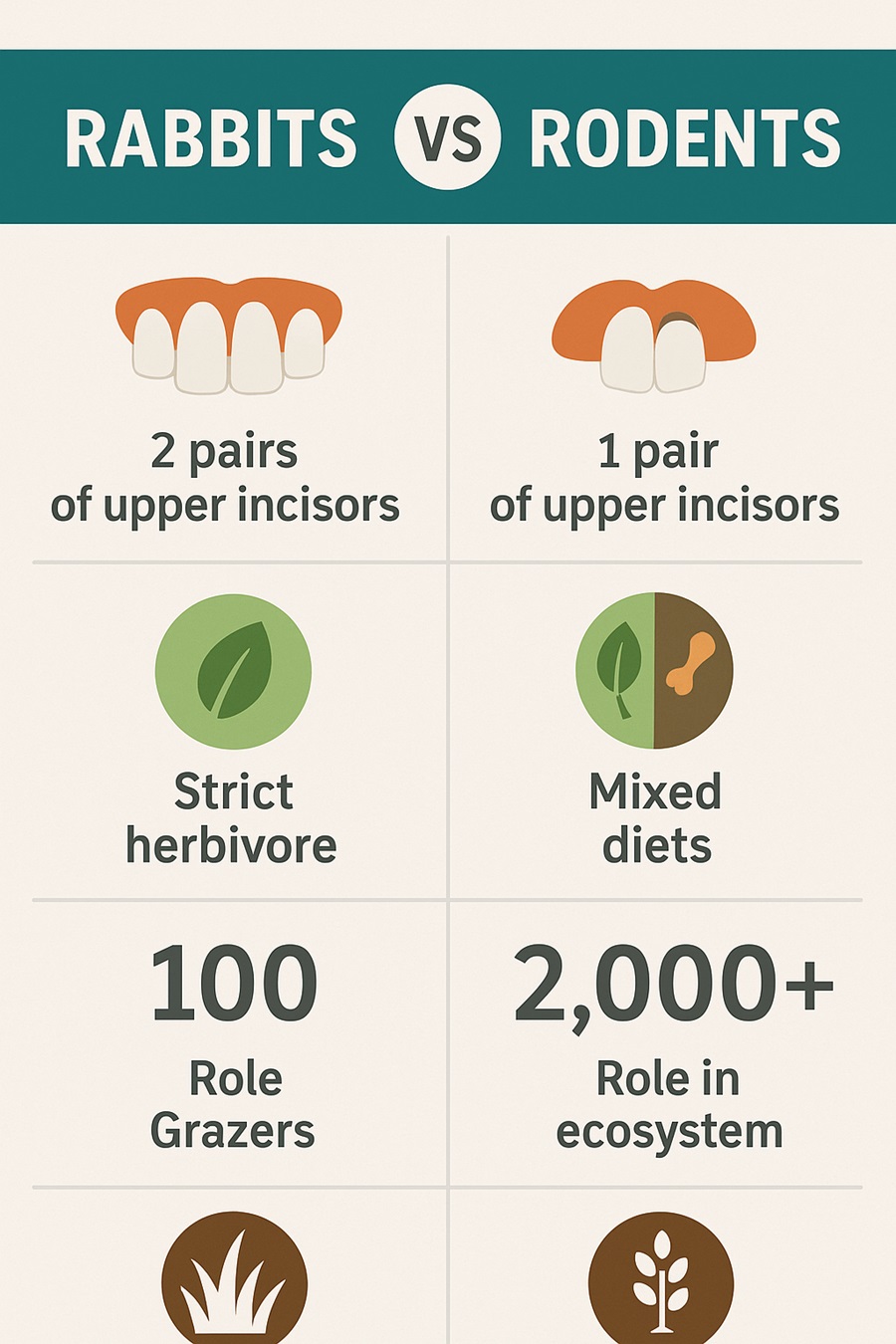
Rabbits vs. Rodents
| Feature | Rabbits (Lagomorpha) | Rodents (Rodentia) |
| Order | Lagomorpha | Rodentia |
| Examples | Rabbits, hares, pikas | Rats, mice, squirrels, guinea pigs |
| Upper Incisors | Two pairs (main + hidden “peg teeth”) | One pair only |
| Diet | Herbivores, hindgut fermenters | Mostly herbivores, some omnivores |
| Digestion | Cecotrophy (re-eating droppings) | No cecotrophy |
| Evolution | Diverged ~55–65 million years ago | Distinct lineage, separate order |
| Role in Nature | Grazers, shape grasslands | Seed dispersers, soil aerators |
How Rabbit Teeth Prove They’re Not Rodents
The strongest evidence comes from their teeth.
- Rodents have one pair of sharp, chisel-like incisors on the top and bottom.
- Rabbits have a second hidden set of incisors — called peg teeth — directly behind the first pair.
This tiny but significant feature convinced scientists to separate rabbits from rodents more than a century ago. In essence, rabbit teeth don’t just help them eat; they prove they’re not rodents at all.
Why Rabbits Look Like Rodents But Aren’t
Despite the differences, rabbits and rodents share a “look.” Why? The answer lies in convergent evolution.
Both groups adapted to survive on fibrous plants. To do so, they independently evolved:
- Ever-growing incisors
- Small, lightweight bodies
- Rapid reproduction to offset high predation
The resemblance is superficial — adaptations for a similar ecological niche — not a sign of close kinship.
The Role of Rabbits vs. Rodents in Ecosystems
Both rabbits and rodents are vital parts of ecosystems, but they play very different roles.
- Rodents: Seed dispersers, soil aerators, and prey for many predators. Some species, however, are notorious for spreading disease.
- Rabbits: Primary grazers that shape grasslands, provide food for carnivores, and influence plant diversity.
In short: rodents engineer ecosystems underground, while rabbits shape them above ground.
Rabbits as Pets vs. Rodents as Pets
Another source of confusion comes from the pet world.
- Rabbits: Social, trainable, and long-lived (8–12 years). Require larger enclosures, hay-based diets, and regular care.
- Rodent pets: Hamsters, rats, mice, and guinea pigs. Generally smaller, shorter lifespans, and less space-demanding.
Pet owners often lump them together, but caring for a rabbit is far closer to owning a small dog than a hamster.
Are Rabbits Pests Like Rodents?
Both rabbits and rodents can be considered pests, but in different ways:
- Rodents: Associated with food contamination, infrastructure damage, and disease.
- Rabbits: Known for crop destruction and overgrazing.
In regions like Australia, rabbits caused ecological collapse after their introduction. Yet unlike rodents, they are also culturally valued and domesticated as pets.
Common Misconceptions About Rabbits
- Myth: Rabbits are rodents.
Fact: They are lagomorphs. - Myth: Rabbits are marsupials.
Fact: They are placental mammals, not pouch-carriers. - Myth: Rabbits only eat carrots.
Fact: Their diet must be mainly hay and fibrous plants to keep teeth healthy.
FAQs
Are rabbits closer to rodents or guinea pigs?
Despite similarities, rabbits are closer to hares and pikas. Guinea pigs are true rodents.
Do rabbits have rodent teeth?
No. Their unique peg teeth set them apart from rodents.
Are hares and pikas rodents?
No. They are also lagomorphs.
Are rabbits marsupials?
No. They are placental mammals, not related to kangaroos or koalas.
Why do people still think rabbits are rodents?
Historical classification and surface similarities keep the myth alive.
Are hares and pikas rodents too?
No. Like rabbits, hares and pikas are lagomorphs, not rodents. They share some similarities with rodents but belong to a separate evolutionary branch of mammals.
Final Verdict – Rabbits Are Lagomorphs, Not Rodents
So, are rabbits rodents? The answer is a firm no. Rabbits belong to the order Lagomorpha, a distinct lineage that split from rodents tens of millions of years ago.
They may look alike due to convergent evolution, but their unique teeth, digestive system, and evolutionary history prove they are something else entirely. Rabbits are not rodents — they are lagomorphs, with a special place in both ecosystems and human culture.


